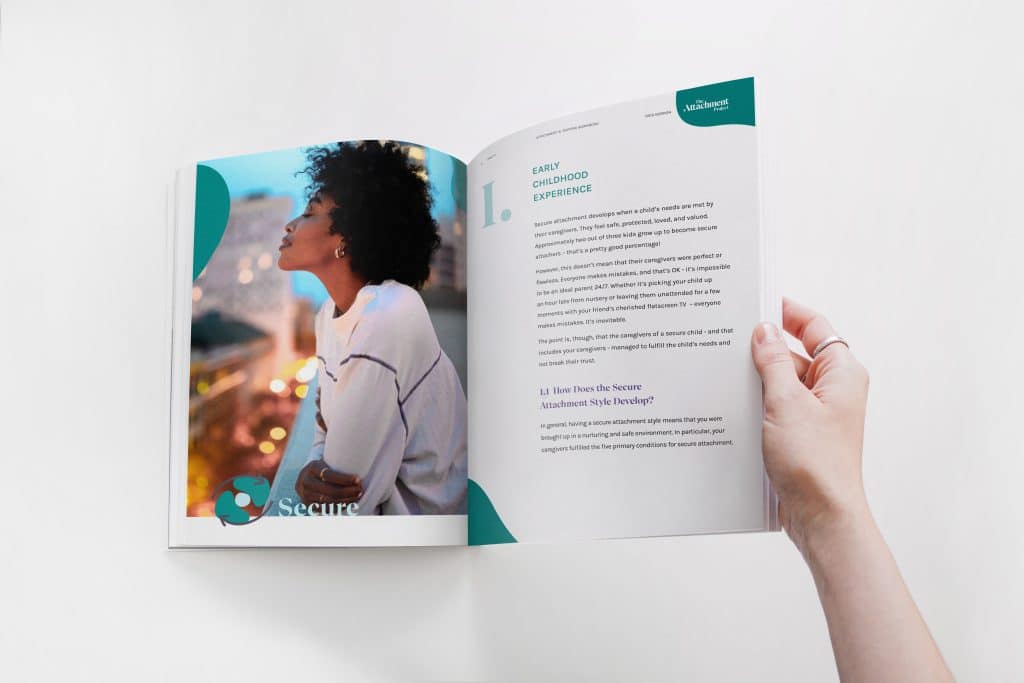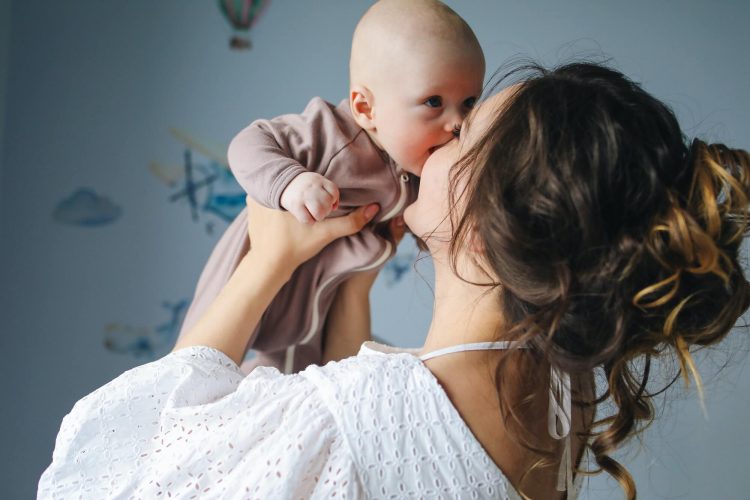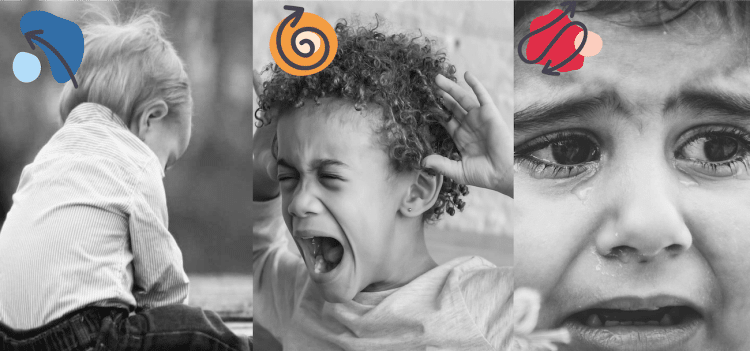Secure Attachment – from Childhood to Adult Relationships

Published on July 2, 2020 Updated on April 6, 2023
What is Secure Attachment?
The secure attachment style is the most common type of attachment in western society. Research suggests that around 66% of the US population is securely attached.
People who have developed this type of attachment are self-contented, social, warm, and easy to connect to. They are aware of and able to express their feelings. They also tend to build deep, meaningful, and long-lasting relationships.
Adults with secure attachment are even well-liked in the workplace.
Parents who want to raise securely attached children might benefit from researching the topic and resolving their own attachment issues, if such exist.
We will cover the most common questions around secure attachment:
- What is attachment theory?
- How does attachment form in early childhood?
- What causes insecure attachment to develop in children?
- How do children develop secure attachment?
- What are the five conditions necessary for developing secure attachment?
- What are ten common signs of secure attachment in an adult relationship?
- What are three clues to look for an adult with secure attachment?
- Can you develop secure attachment as an adult?
What is attachment theory?
People often joke that if you go to a therapist, you will be ‘questioned’ about your childhood. While not always, it definitely is true if you are visiting a therapist for relationship issues.
Why? The answer lies in attachment theory, which dates back to the 1950’s. According to psychiatrist and psychoanalyst John Bowlby, our early relationships with our parents (or caregivers) shape the way we perceive and act in relationships throughout our lives.
So, how does this work? As infants/children, we are dependent on our parents or primary caregivers. We need them for survival, so we have no other option than to attach to them and trust that they will take good care of us.
In most cases, parents will do their best to satisfy all our needs and provide us with a warm and nurturing environment.
If they are attuned and responsive to our needs, we are able to build a secure and stable relationship with them, and consequently, a secure attachment style.
Yet, if they are not, or if we perceive that our needs are not met, we are likely to develop one of the three attachment styles categorized as insecure.
The three insecure attachment styles are
- Anxious (or preoccupied; referred to as anxious ambivalent in children)
- Avoidant (or dismissive; referred to as anxious avoidant in children)
- Disorganized (referred to as fearful-avoidant in children)
What causes insecure attachment?
Insecure attachment styles are often caused by misattuned parenting, childhood trauma, or abuse.
They could have a strong negative impact on the individual’s mental health, social behavior, and ability to build stable and long-lasting intimate relationships in adulthood.
It is essential to note that there is no such thing as a perfect parent.
Our caregivers most probably made mistakes raising us, and we ourselves (will) sometimes screw up as parents. That does not necessarily mean that we have attachment issues, or that we will raise a child with such. Keep in mind that about two-thirds of children develop a secure attachment style.
How do children develop a secure attachment style?
When a child is born, they automatically expect that their caregivers will satisfy their needs.
The baby uses physical cues (such as crying) to notify the caregivers that something’s wrong and trusts that they will take care of the issue.
Parents who manage to raise children with a secure attachment style simply do not break that trust. Yet, this is not always as simple as it sounds.
There are five key conditions to consider, as a parent, if you are devoted to raising a child with a secure attachment style.
The 5 conditions necessary for raising a child with secure attachment
1. The child feels safe
First and foremost, as a parent you want your child to feel protected. If your child feels protected, it feels safe.
For the infant and toddler, safety means closeness to the mother, as she is the source of food, warmth, and protection. Danger means separation from her, beyond the comfort zone.
The attuned mother is fiercely protective but not overwhelming, intrusive, or ignoring. She gives her child space and freedom to explore the world, but stays close enough, so that the child has a felt sense of safety.
When the infant strays too far and becomes frightened, they know that they can run to her and envelop her in a warm, protective embrace, secured against the world.
This conveys a message: “You are safe. You are loved. You are lovable.”

2. The child feels seen and known
Attuned parents can read their baby’s cues accurately and respond to their needs accurately.
Attuned responses give infants information about the effects of their behavior.
Children learn that when they signal a need, they can expect a prompt, predictable, and accurate response.
The result for the baby is a feeling of control over their lives, starting early on:
- When I signal that I’m hungry, and I get fed
- If I signal that I’m tired, and my caregiver rocks me to sleep
- When I signal that I’m upset, and my caregiver soothes my distress
3. The child feels comfort, soothing and reassurance
The attuned parent’s arms are open and inviting.
When the child is distressed, the caregiver reassures and soothes the child back to a calm emotional state.
Helping the child manage their distress and frustrations will help them develop an internal model of being soothed and comforted.
Over time, the child will develop the ability to manage his or her own distress and self-soothing.
4. The child feels valued
Feeling valued begins in infancy and is the foundation of healthy self-esteem development.
Parents who raise children with healthy self-esteem repeatedly express their joy about who the child is rather than what the child does. They focus on Being rather than Doing.
Such parents exhibit “expressed delight” to the child and about almost everything the child does. They focus not on the chores, but on the joys of parenting.
5. The child feels supported to explore
Lastly, children need to feel supported to explore their world joyfully and safely.
Parents who champion this have a deep faith in their child and always provide him or her with a safety net. Deeply involved in their child’s life, parents give the child space and thrust him or her towards autonomy and independence.
This sense of security allows the child to explore, discover, succeed, and fail; and through such exploration, the child develops a good, autonomous, strong, and unique sense of self.
Being as predictable as possible with the child
Now, let’s go back to the point of not breaking the child’s trust in you. The key here does not lie in the details, but rather in your general approach towards parenting. A small mistake, here and there, will not cause your child to become insecurely attached to you.
There are, however, a few things you might want to aim at. Inconsistency (in parents) is one of the key risk factors for the development of insecure attachment styles (in children).
Do not change your strategy too often. Knowing what to expect gives the child a sense of stability and calmness. You do not want your child to be on edge all the time.
Another central risk factor for building an insecure attachment with your child is not being aware of your own emotions and emotional needs. If you have an insecure attachment style yourself, you are likely to pass it on to the next generation.
So, if you suspect you might have attachment issues, it may be a good idea to make sense of those with someone close to you, with a therapist, or through self-help books and online courses.
One final note here: keep calm. You don’t need to stress over each and every detail of your parenting or relationship with your child: secure attachment is all about the child’s trust in you and your love.

10 signs of secure attachment in adult relationships
- Able to regulate emotions and feelings in a relationship
- Strong goal-oriented behavior when on your own
- Great at bonding, opening up to, & trusting others
- Knowing what you’re about in life and what purpose you want to fulfill
- Can communicate your needs effectively
- Feeling like you have an impact on the world around you
- Comfortable with closeness & mutual dependency
- Actively seek emotional support from your partner and also give emotional support to your partner
- Comfortable being alone and use that time to explore
- Strong capacity to reflect on how you are being in a relationship
3 clues to look for secure attachment in adults
Adults with a secure attachment style tend to have it easier when it comes to social contacts, bonding, and intimate relationships.
They are aware of their emotions and emotional needs and are able to both experience and express those. They are open and straightforward and do not go to extremes.
1. Positive view of self
Securely attached adults have a positive view of themselves. They do not need reassurance in order to feel valued or worthy of love.
Yet, this does not mean they reject or do not want intimacy or emotional closeness. They simply feel good on their own as well as in relationships.
2. Positive view of others
These individuals also have a positive view of others. They tend to trust their partners and do not feel the need to be jealous or doubt their loved ones’ intentions.
They are able to accept displays of affection, without fear or confusion. People with a secure attachment style are most commonly warm, loving, and lovable.
They aim at and are capable of building and maintaining meaningful and long-lasting romantic relationships. They are comfortable with proximity and bond easily with others.
3. Positive view of childhood
Securely attached adults also tend to have a positive view of their childhood.
They are able to reflect on and make sense of their past experiences, even if their childhood was not perfect. They appreciate the good and understand and move on from the bad.
Can you develop a secure attachment style in adulthood?
If you match the profile described above, you should probably take a moment to be grateful for that.
Thank your parents. If you suspect that your attachment style is not entirely secure, you might be wondering whether you can change it and make it secure.
The good news is that you can develop secure attachment as an adult.
It might be a good idea to get acquainted with the three types of insecure attachment first.
Reading through some articles might give you a better idea of where you stand in the picture. Bear in mind that you do not need to fully match a certain profile. You are unique and have a unique life history.
Don’t know your attachment style? Take our short 5 minute Attachment Style Quiz to find out now. It’s completely free.

Attachment Style Workbooks
If you’d like to use attachment theory to build better and more secure relationships with everyone around you, our workbooks are the perfect place to start!
Empower your Instagram newsfeed
If you liked this post and want to learn more about attachment theory, then we recommend following The Attachment Project on Instagram. We want to help you make sense of your attachment style in various contexts.
Sources:
Bowlby, J. (1988). A Secure Base: Parent-Child Attachment and Healthy Human Development. Tavistock professional book. London: Routledge.
Brown, D. P., & Elliott, D. S. (2016). Attachment disturbances in adults: Treatment for comprehensive repair. WW Norton & Co.
Keller, H. (2018). Universality claim of attachment theory: Children’s socioemotional development across cultures. PNAS, 115(45), 11414-11419.
Mikulincer, M., Shaver, P.R. (2007). Attachment in Adulthood: Structure, Dynamics, and Change. Guilford Press.











 Get mental health tips straight to your inbox
Get mental health tips straight to your inbox








